
Introduction
Avec cette Earthcache, nous allons nous intéresser aux fossiles présents sur le géosite de Fresville. Cette ancienne carrière de calcaire, aujourd’hui aménagée en lieu de promenade autour d’un plan d’eau, est protégée et administrée par le Parc des marais du Cotentin et du Bessin. La richesse en fossiles du site est telle que « le club géologique du Cotentin – Fresville fossiles » y a installé ses locaux.
Attention ! Vous avez le droit de récupérer les fossiles détachés de la falaise que vous trouvez sur le sol ; mais en aucun cas, vous avez le droit de prospecter, c’est-à-dire de casser la roche à l’aide d’outils. Merci de bien respecter les lieux !
Qu'est-ce qu'un fossile ?
Le mot « fossile » vient du latin fossilis qui signifie « que l’on a tiré de la terre ». Un fossile est le reste ou une trace d’être vivant animal ou végétal conservé dans des roches et mort il y a plusieurs millions d’années. Ces restes fossilisés peuvent être des coquilles, des carapaces, des os, des dents, des feuilles, des écorces, des graines, ... qui se sont généralement minéralisés, ou bien alors des simples moulages, conservés dans une roche sédimentaire.

Moulage Fossile minéralisé
Comment se forment les fossiles ?
D'ordinaire lorsqu'un animal meurt, son corps est rapidement dévoré par les charognards mais aussi dégradé par les bactéries, l'eau et les éléments chimiques contenus dans le sol. Et donc le phénomène de fossilisation n'est pas possible.
Pour qu’il y ait fossilisation, il faut que l'animal mort soit rapidement recouvert de sédiments (sable fin, boue, vase, …) qui le protège de la destruction. Ensuite l'oxygène dégrade les parties organiques « molles » (organes, muscles, tissus) pour ne laisser que les parties dures (os, dents, coquilles).
Puis, pendant plusieurs millions d'années, les parties dures sont recouvertes par des sédiments. Les sédiments finissent par rentrer dans les pores des parties dures. Puis grâce à une diagenèse, les sédiments se transforment alors en roche. C’est la fossilisation.
Mais le fossile n'est pas encore accessible. Il faut attendre des mouvements géologiques pour que le fossile remonte à la surface et qu’il puisse enfin être découvert. L’activité de l’homme peut également favoriser leur mise à jour : fouilles archéologiques, exploitation de mines ou de carrières. A Fresville, c’est justement l’exploitation de la carrière de calcaire pour la cimenterie du Ham qui a permis la découverte de tous ces fossiles.

Pourquoi tant de fossiles à Fresville ?
Découvert lors du creusement de la carrière, la forte présence de fossiles à Fresville s’explique par la nature marno-calcaire de son sol. Il s’agit d’une formation géologique qui alterne des strates de calcaires et de roches sédimentaires, la marne. Or, les calcaires sont souvent fossilifères. Dans le cas de Fresville, on parle tout particulièrement de calcaire à gryphées, car on retrouve ici de grandes quantités de fossiles de gryphées qui s’accumulent parfois sous forme de lumachelles. On appelle lumachelle une roche sédimentaire contenant un grand nombre d'organismes fossiles entiers ou brisés accumulés par sédimentation.
La présence de nombreux fossiles de mollusques marins comme les gryphées ou encore les ammonites, confirme l’origine marine de ces dépôts de sédiments et leur appartenance aux terrains de l’ère Secondaire (Mésozoïque) et plus précisément du Sinémurien, un étage classique du Jurassique inférieur (Lias) compris entre – 196 Ma et – 189 Ma. Cette datation est relativement précise grâce à la présence de gryphées qui sont considérées comme des bons fossiles stratigraphiques (= qui permettent la datation).
Grâce à l’étude des fossiles trouvées à Fresville, les paléontologues peuvent affirmer qu’à cette époque, la vie sous-marine explose : des céphalopodes (ammonites et bélemnites) pullulent, les gryphées colonisent les fonds vaseux, des ichtyosaures se nourrissent de poissons et de céphalopodes.
Qu’est-ce qu’une gryphée ?
Gryphaea (gryphée en français) est un peu l’emblème du géosite de Fresville. La gryphée est un genre éteint de mollusques proches de l'huître ayant vécu du Trias supérieur au Crétacé.
Pour se nourrir, elle filtrait l’eau de mer et se nourrissait de planctons tout comme les huitres de nos jours. Il s’agit d’un mollusque bivalve ayant une coquille assez allongée, relativement arquée. L’une des valves est très creuse, l’autre plate ou concave, bien plus petite. Le crochet est saillant et bombé, recourbé vers la petite valve. La gryphée vivait en petite colonie dans les zones côtières entre 0 et 50 m de profondeur et pouvait vivre quelques décennies comme en attestent les stries de croissance très marquées qui ornent leur coquille.
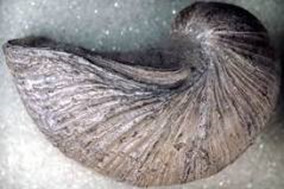
Les autres principaux fossiles de Fresville :
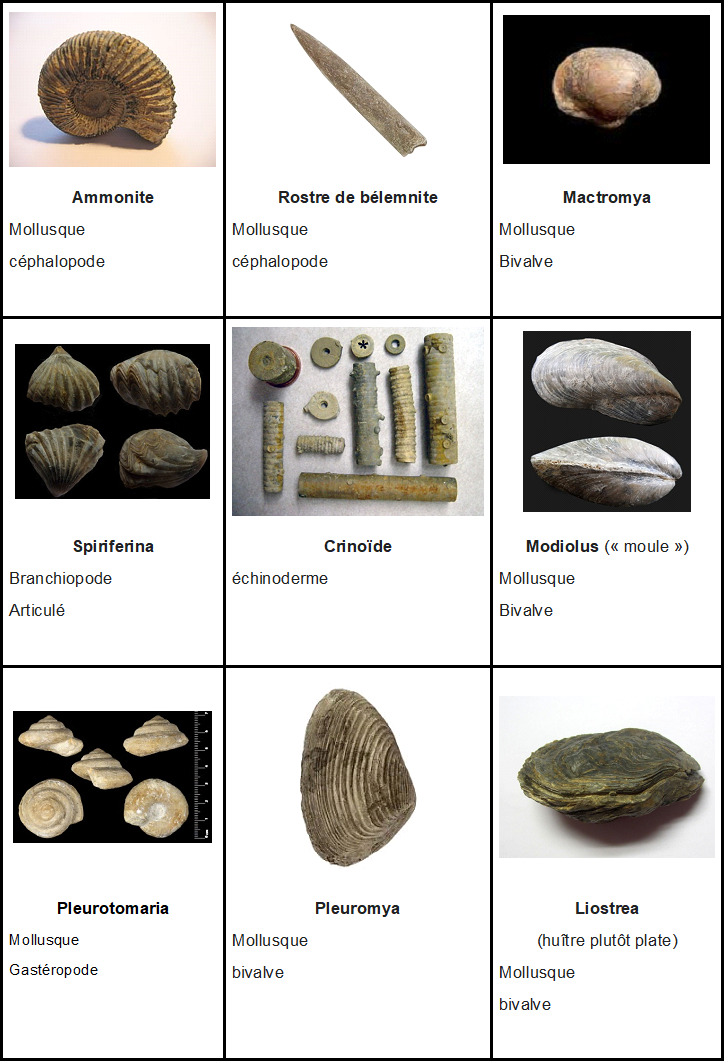
Petit lexique :
Mollusque : Animal invertébré au corps mou (embranchement des mollusques : céphalopodes, gastéropodes, bivalves).
Céphalopode : mollusque supérieur qui a un pied à tentacules munis de ventouses.
Gastéropode : Mollusque au large pied charnu qui lui sert à ramper.
Bivalve : Mollusque qui a deux valves (= 2 coquilles). Syn. Lamellibranche.
Branchiopode : Crustacé primitif possédant sur le tronc des appendices aplatis, ses branchies
Echinoderme : Invertébré marin à symétrie radiale.
Pour valider la Earthcache
Rappel concernant les Earthcaches: Il n'y a pas de conteneur à rechercher ni de logbook à renseigner. Il suffit de se rendre sur les lieux, de répondre aux questions et de me renvoyer les réponses
Pour pouvoir valider cette EarthCache, vous devrez répondre correctement aux questions suivantes et envoyer vos réponses via mon profil ou via la messagerie geocaching.com, ne les donnez pas dans votre log. Les logs enregistrés sans réponses de même que les logs sans photo seront supprimés (la photo étant ici une condition de validation de la earthcache telle que les guidelines l’autorisent).
Vous pouvez loguer la cache "trouvé" sans attendre ma confirmation, je vous contacterai en cas de problème.
Questions :
A partir du descriptif :
1 : Comment appelle-t-on le passage de l’être vivant au fossile ?
2 : Est-ce un processus rapide ou lent ?
3 : De quelle ère géologique les fossiles de Fresville sont-ils les témoins ?
4 : De quel mollusque actuel la gryphée est-elle l’ancêtre ?
WP 1 : le spot à fossile N 49° 26.445 W 001° 22.829
5. Partez ici à la recherche d’un fossile au sol ou sur la falaise, prenez–le en photo et joignez la photo à votre log.
6. Via la messagerie, décrivez-moi votre fossile photographié : Taille ? Couleur ? Forme ou aspect général ? Entier ou pas ? Simple moulage ou fossile minéralisé ?
7. A l’aide du descriptif et de vos observations, identifiez votre fossile : Est-ce un fossile d’origine animale ou végétale ? Est-ce un fossile marin ? Votre fossile est celui d’un mollusque, d’un branchiopode ou d’un échinoderme ? Est-ce un céphalopode, gastéropode ou bivalve ? Quel est son nom ?
Attention ! La photo est obligatoire pour pouvoir valider cette earthcache. Tout log sans photo de fossile sera automatiquement effacé !

Introduction
With this Earthcache, we are going to focus on the fossils present on the geosite of Fresville. The Fresville geosite is protected and administered by the Parc des Marais du Cotentin et du Bessin. The Cotentin Geology Club “Fresville Fossiles” has its premises there, including an exhibition room where the club exhibits the products of its research, and in particular the minerals and fossils of Fresville. The strong presence of fossils in Fresville is explained by the marl-limestone nature of its soil. However, limestones are often fossiliferous.
Attention ! You have the right to recover the fossils detached from the cliff that you find on the ground; but in no case, you have the right to prospect, that is to say to break the rock using tools. Thank you for respecting the place!
What is a fossil?
The word "fossil" comes from the Latin fossilis, which means "taken from the earth". A fossil is the remains or a trace of a living animal or plant preserved in rocks and dead several million years ago. These fossilized remains can be shells, carapaces, bones, teeth, leaves, bark, seeds, etc. which have generally become mineralized, or even simple casts preserved in sedimentary rock.
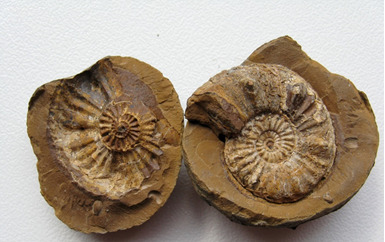
Cast Mineralized Fossil
How are fossils formed?
Usually when an animal dies, its body is quickly devoured by scavengers but also degraded by bacteria, water and chemical elements contained in the soil. And therefore the phenomenon of fossilization is not possible.
For there to be fossilization, the dead animal must be quickly covered with sediment (fine sand, mud, silt, etc.) which protects it from destruction. Then the oxygen degrades the “soft” organic parts (organs, muscles, tissues) to leave only the hard parts (bones, teeth, shells).
Then, for several million years, the hard parts are covered by sediments. The sediment eventually enters the pores of the hard parts. Then thanks to a diagenesis, the sediments are then transformed into rock. This is fossilization.
But the fossil is not yet accessible. It is necessary to wait for geological movements for the fossil to rise to the surface and for it to finally be discovered. Human activity can also promote their discovery: archaeological excavations, exploitation of mines or quarries. In Fresville, it is precisely the exploitation of the limestone quarry for the Ham cement factory that led to the discovery of all these fossils.
The process of fossilization
Usually when an animal dies, its body is quickly devoured by scavengers but also degraded by bacteria, water and chemical elements contained in the soil. And therefore the phenomenon of fossilization is not possible.
For there to be fossilization, the dead animal must be quickly covered with sediment (sand, mud) to avoid attack by scavengers. Then the oxygen degrades the organic parts (organs, muscles, tissues) to leave only the hard parts (bones, teeth, shells).
Then, for several million years, the hard parts are covered by sediments. The sediment eventually enters the pores of the hard parts. Then thanks to a diagenesis, the sediments then turn into stone. So we get a fossil.
But the fossil is not yet accessible. Thanks to geological movements, the fossil rises and approaching the surface it can finally be discovered.
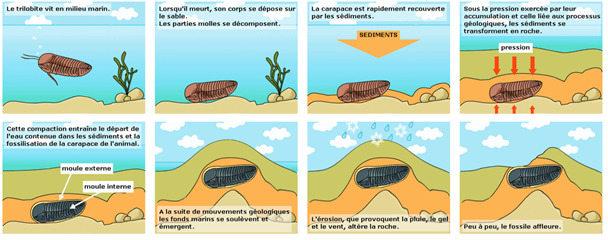
Why so many fossils in Fresville?
Discovered during the digging of the quarry, the strong presence of fossils in Fresville is explained by the marl-limestone nature of its soil. It is a geological formation that alternates strata of limestone and sedimentary rocks, marl. However, limestones are often fossiliferous. In the case of Fresville, we speak in particular of gyphaeous limestone, because here we find large quantities of gyphaean fossils which sometimes accumulate in the form of lumachelles. A sedimentary rock containing a large number of whole or broken fossil organisms accumulated by sedimentation is called lumachelle.
The presence of numerous fossils of marine molluscs such as gryphea or ammonites, confirms the marine origin of these sediment deposits and their belonging to the lands of the Secondary era (Mesozoic) and more precisely of the Sinemurian, a classic stage of the Jurassic. lower (Lias) between – 196 Ma and – 189 Ma. This dating is relatively precise thanks to the presence of gryphaea which are considered to be good stratigraphic fossils (= which allow the dating).
Thanks to the study of fossils found in Fresville, paleontologists can affirm that at that time, underwater life exploded: cephalopods (ammonites and belemnites) swarmed, gryphaea colonized the muddy bottoms, ichthyosaurs fed on fish and cephalopods.
What is a Grypheus?
Gryphaea (gryphée in French) is a bit like the emblem of the Fresville geosite. The gryphée is an extinct genus of molluscs close to the oyster that lived from the Upper Triassic to the Cretaceous.
To feed, it filtered seawater and fed on plankton just like oysters today. It is a bivalve mollusk with a fairly elongated, relatively arched shell. One of the valves is very hollow, the other flat or concave, much smaller. The hook is prominent and domed, curved towards the small valve. The grypheus lived in small colonies in coastal areas between 0 and 50 m deep and could live for a few decades, as evidenced by the very marked growth streaks that adorn their shell.
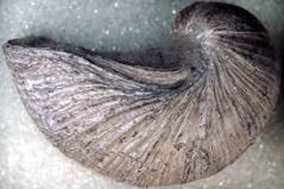
The other main fossils of Fresville:

Small lexicon:
Mollusc: Soft-bodied invertebrate animal (mollusc branch: cephalopods, gastropods, bivalves).
Cephalopod: superior mollusk with a foot with tentacles provided with suction cups.
Gastropod: Mollusc with a large fleshy foot which it uses to crawl.
Bivalve: Mollusc that has two valves (= 2 shells). Syn. Lamellibranch.
Branchiopod: Primitive crustacean with flattened appendages on the trunk, its gills
Echinoderm: Marine invertebrate with radial symmetry.
To validate the Earthcache
Reminder about Earthcaches: There is no container to search for or logbook to fill in. Just go to the place, answer the questions and send the answers back to me.
To be able to validate this EarthCache, you will have to answer the following questions correctly and send your answers via my profile or via geocaching.com messaging, do not give them in your log. Logs recorded without answers as well as logs without a photo will be deleted (the photo here being a condition of validation of the earthcache as authorized by the guidelines).
You can log the "found" cache without waiting for my confirmation, I will contact you in case of problem.
Questions :
From the description:
1: What is the transition from living being to fossil called?
2: Is it a fast or slow process?
3: What geological era do the fossils of Fresville bear witness to?
4: Of which modern mollusk is the gypheus the ancestor?
WP 1: the fossil spot N 49° 26.445 W 001° 22.829
5. Go here in search of a fossil on the ground or on the cliff. Take a photo of it and attach the photo to your log.
6. Via email, describe your photographed fossil to me: Size? Color ? Shape or general appearance? Whole or not? Simple cast or mineralized fossil?
7. Using the description and your observations, identify your fossil: Is it a fossil of animal or plant origin? Is it a marine fossil? Is your fossil that of a mollusc, a branchiopod or an echinoderm? Is it a cephalopod, gastropod or bivalve? What's her name?
Attention ! The photo is mandatory to be able to validate this earthcache. Any log without a fossil photo will be automatically deleted!